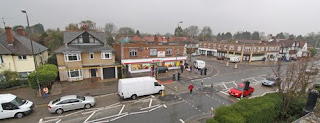As I discovered while writing my book - Energy and carbon emissions: the way we live today - it isn't always obvious how our everyday choices add up in terms of energy use and carbon emissions. This blog aims to paint you an objective picture - and sometimes surprise you.
Wednesday, 30 March 2011
Pedestrians use fuel too
Pedestrians don't use fuel directly - but when we stop the traffic at a pedestrian crossing then the cars and lorries forced to slow down use more than they would have done.
Even a small city car weighs at least 900kg by the time it has a driver in it and perhaps a handbag. A bus will be 9-12 tonnes (1 tonne = 1000kg). If you stop 10 tonnes worth of vehicles from 30mph at a crossing, you have just used 0.25 kWh or 75ml diesel fuel (assuming the power train is 33% efficient, which is optimistic for diesel vehicles). Do that 13 times and you have used 1 litre.
Electric cars are more efficient so they need less energy to regain their speed and they usually have some sort of regenerative braking as well which could get half of the lost energy back. Lorries and buses can have regenerative braking too - using either flywheels or hydraulic capacitors and there are now commercial options for vans too. Regenerative braking will never be close to 100% efficient but fuel savings of 25% in urban cycles are not uncommon(1).
Pedestrian crossings aren't the only reason vehicles have to stop and start in heavy traffic. Traffic modelling has shown that reducing congestion in general could reduce HGV fuel consumption by 50%(2), (regenerative braking will only get back half of this). As a pedestrian I don't think I need to feel guilty about pressing the button if I need to. However, this is an argument against night time curfews for lorry deliveries, given that this inevitably increases congestion and fuel use for everyone - and ultimately greenhouse gas emissions.
1. Ford Hytrans 2005 Van Review
2. David Cebon: Energy and Environment - Driving Heavy Vehicle Policy, Design and Operations
Labels:
transport
Subscribe to:
Post Comments (Atom)

No comments:
Post a Comment
Comments on this blog are moderated. Your comment will not appear until it has been reviewed.